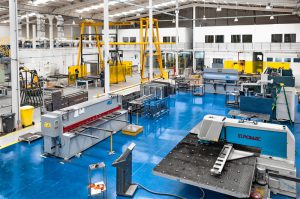- November 20, 2019
- Posted by: David Marshall
- Category: Management, Productivity, Safety

A friend was recently telling me about when he worked in a restaurant. When there were only a few customers, his manager used to say, “If there’s time to lean, there’s time to clean,” which is something I’ve heard myself over the years.
It’s an important sentiment in some situations, like waiting tables at a restaurant. If there’s no one there, then take some time to do the cleaning that normally doesn’t happen. Dust the chair legs, wipe down the server shelves, wipe under the table with some heavy-duty disinfectant.
However, that’s not a useful sentiment when you’re working in a factory. In fact, it can be downright dangerous.
It’s dangerous because the workers only clean their workstations when things are slow. And depending on the production schedule, there may not be a slowdown period for days or even weeks. If you only cleaned when you had time between orders, you could have a dangerous buildup of grease, metal filings, PVC pellets, and/or dust which could cause a machine to break or someone to get hurt.
Instead, I had an expectation of constant cleaning by all the associates on the floor. I didn’t even want daily cleaning periods, I wanted constant, regular, ongoing cleaning. If you
This was a daily expectation, because I figured if people paid attention to their workstation’s cleanliness, then their attention to detail also went up, which meant other things would benefit like safety and quality improvement.
Constant cleaning also had another benefit by reducing the overall maintenance.
 The funny thing is if you’re looking at a dirty piece of equipment, you won’t see beyond the dirt. You would look at the dirt and fail to see when something is wearing down. If you miss that something is wearing, then you won’t see it until it breaks. And if that happens, it could be something that either hurts someone or costs tens of thousands of dollars to repair.
The funny thing is if you’re looking at a dirty piece of equipment, you won’t see beyond the dirt. You would look at the dirt and fail to see when something is wearing down. If you miss that something is wearing, then you won’t see it until it breaks. And if that happens, it could be something that either hurts someone or costs tens of thousands of dollars to repair.
But by increasing the overall attention to detail, we were able to get a far broader level of engagement. In other words, the more people would be intellectually and emotionally engaged, the better everything was. It improved several areas because people’s minds weren’t cluttered.
In Anthony Bourdain’s book, Kitchen Confidential, he talks about a cook’s mise-en-place (pronounced MEEZ-on-plas), which is their workstation. They often just called it “the meez.”
He said that cooks who let their meez get dirty would often get into trouble, fall behind, get into the weeds, and then start making all kinds of mistakes.
If you let your mise-en-place run down, get dirty and disorganized, you’ll quickly find yourself spinning in place and calling for backup. I worked with a chef who used to step behind the line to a dirty cook’s station in the middle of a rush to explain why the offending cook was falling behind. He’d press his palm down on the cutting board, which was littered with peppercorns, spattered sauce, bits of parsley, bread crumbs and the usual flotsam and jetsam that accumulates quickly on a station if not constantly wiped away with a moist side towel. “You see this?” he’d inquire, raising his palm so that the cook could see the bits of dirt and scraps sticking to his chef’s palm. “That’s what the inside of your head looks like now.”
I felt the same way about associates’ workstations. They had to keep it clean all the time. Not only that, but my rule was “if you’re standing next to it, you own it.”
In other words, if a dog walked by (not that we had a lot of dogs running around our factory) and it crapped on the floor next to you, it’s not up to the dog to clean it up. If you’re standing next to the problem, then the problem is yours, so clean it up. Saying “it’s not my job” is not acceptable; it’s everyone’s job to ensure that the housekeeping is perfect.
In other companies, people are very comfortable in silos. If there’s a mess, that’s up to a janitor or maintenance person to clean. If a machine needs a little attention, that’s up to the maintenance person.
But I didn’t let people slough off and leave problems to someone else. They couldn’t just pass off their problems. They were responsible for ensuring their machine was working and free of wear. They were responsible for their personal protective equipment.
And that meant they were responsible for constantly cleaning their workstations instead of leaning during the slow times.
I’ve been a manufacturing executive, as well as a sales and marketing professional, for a few decades. Now I help companies turn around their own business. If you would like more information, please visit my website and connect with me on Twitter, Facebook, or LinkedIn.
Photo credit: PXHere.com (Creative Commons 0)

